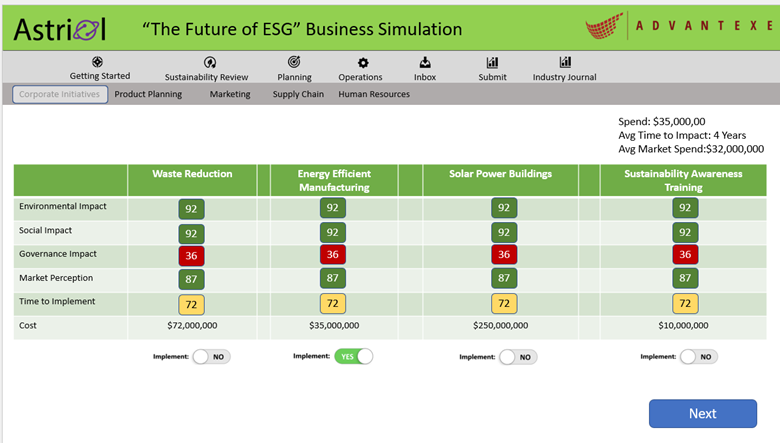One of the most interesting elements of designing Business Acumen training programs for business leaders is to engage with them about their challenges and opportunities and how to build the organizational capabilities to move forward.
is to engage with them about their challenges and opportunities and how to build the organizational capabilities to move forward.
Over the past few years, having an Environmental, Sustainability, and Governance (ESG) strategy has been at the forefront of thought for many leaders. During this time, Advantexe has been approached on numerous occasions to either integrate ESG into our existing business simulations or create new ESG simulations for specific clients in specific industries. Our Solution Architects who design simulations and learning journeys always get excited and start to integrate new ideas into the simulations including packaging, production, transportation, materials management, and much more.
And then “it” happens…
We present great ideas about integrating ESG into the simulations and then it becomes obvious very quickly that yes, sure we need more ESG, so let’s throw money at it because it’s “just a simulation,” “it’s not our money,” and “I guess they want us to spend money on ESG anyway.” At this moment, a noble idea turns into “greenwashing” meaning that it has morphed from being real and practical into an extension of Marketing.
Obviously, that doesn’t make for good learning and doesn’t build any capabilities.
Which raises the question, what does?
Why ESG and Why Now
ESG has always mattered, but there’s a reason it’s becoming such a significant point of conversation. ESG has emerged as a key factor that investors look to when considering risk. If a company is serious about the future in terms of revenue, profit, and free cash flow, then it will have a real ESG strategy. That is the Business Acumen of ESG.
This is important in every industry and for every company. Especially in the new reality of the post-pandemic world where the economy, the environment, and the needs of the future planet are at risk. Having an ESG strategy goes a long way toward addressing and preparing for those risks. Our perspective is that it can't be reactive, and you can’t just throw money at it. It must be practical…
A Practical Approach to ESG
There’s no one-size-fits-all approach to ESG prioritization and implementation, just like there’s no one-size-fits-all approach to business strategy. Whether it is energy efficiency, carbon emissions, health, and safety, or something serious like price fixing, these are all topics that fit within an ESG strategy.
I share that the practical process is to have the same sorts of conversations about ESG as you do about the selection and execution of business strategy. And when you do this you will soon start to realize there is no difference; it is your business strategy! Using strategic frameworks can help distill and clarify an otherwise potentially overwhelming undertaking. It’s worthwhile to have hard conversations up front to ensure that an ESG initiative is true to your organization and its value propositions and is also realistic to implement. It is imperative for organizations to undergo a process of understanding their impact and getting clear on how they can have influence in the most meaningful way. The word meaningful is critical here. You can’t just throw money at it. As shared earlier, this is just greenwashing and creating perceptions through Marketing.
Building ESG Capabilities
Building capabilities in Business Acumen always starts with strategy. What is your aspiration, what is your value proposition to your customers, and how will you win in your chosen markets? It must be the same approach when building ESG capabilities. From a strategic perspective, we propose that there are five key elements that build an approach and therefore the capabilities needed to implement them. They include:
- Environmental Impact
- Social Impact
- Governmental Impact
- Market Impact
- Time to Implement
The “how part” can be a little more challenging. As part of our research toward designing and building a powerful ESG simulation, we identified four key execution elements including:
- Waste Reduction
- Energy Efficiency in Manufacturing
- Smart Buildings
- ESG Training
The culmination of the simulation experience is achieving business and ESG success through a return-on-investment analysis (ROI). Each program, each project, and each initiative has a cost to it and the hope is there is a significant short and long-term return. In doing some research for this blog, I found a free report from Deloitte that does a great job of sharing deep insights and data about ESG initiatives, their ROIs, and some effective benchmarking.
The Future of ESG
Instead of sitting back and reacting to the future, it’s time to set the future. Below is a brief glimpse of our new ESG business simulation that embraces the approach shared in this blog. The future will be controlled by strategy and actions. It will be driven by setting aspirational goals and then executing plans to achieve them with a strong ROI that is connected to the key measures of performance that support your strategy. Please contact jim.brodo@advantexe.com if you would like to learn more about our new sustainability simulation.





